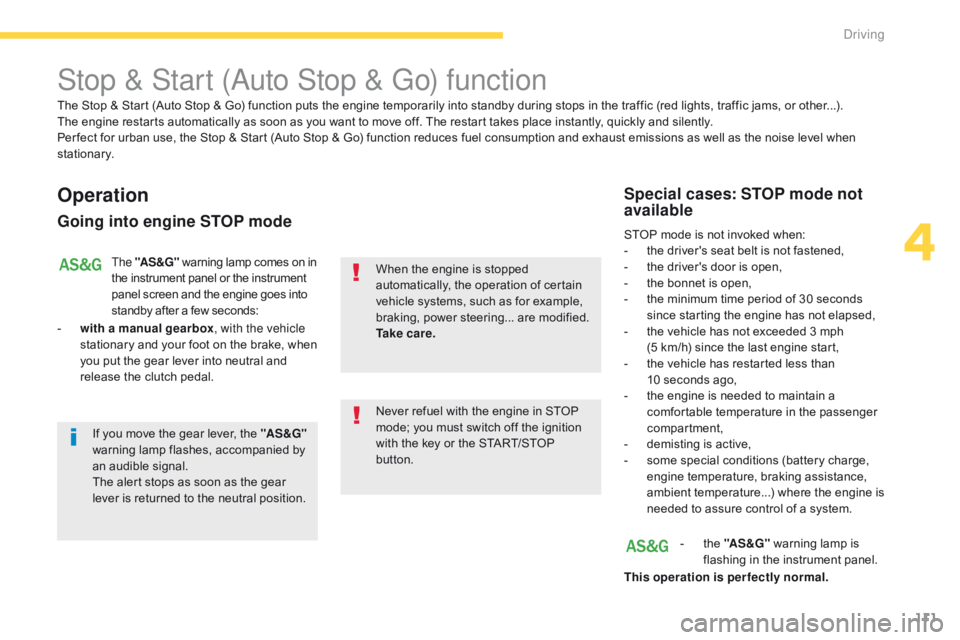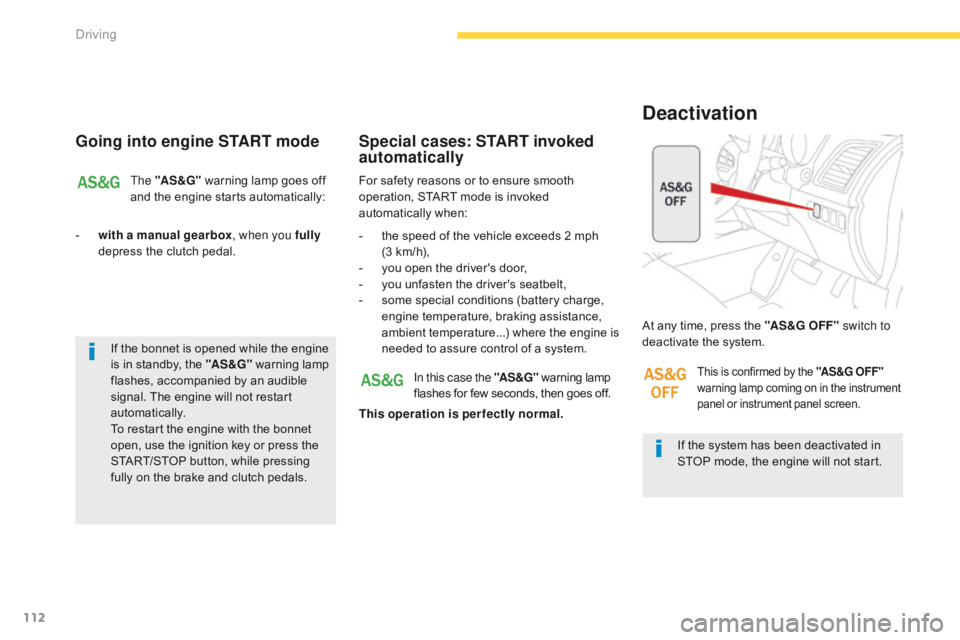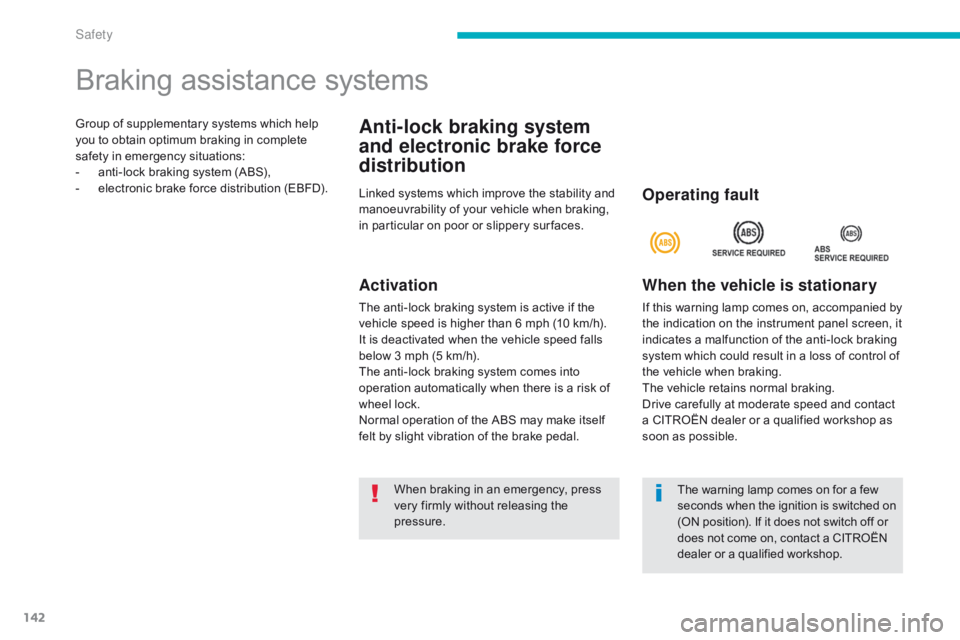warning CITROEN C4 AIRCROSS 2021 Handbook (in English)
[x] Cancel search | Manufacturer: CITROEN, Model Year: 2021, Model line: C4 AIRCROSS, Model: CITROEN C4 AIRCROSS 2021Pages: 414, PDF Size: 20.29 MB
Page 112 of 414

110
Hill start assist
System which keeps your vehicle immobilised
temporarily (approximately 2 seconds) when
starting on a gradient, the time it takes to
move your foot from the brake pedal to the
accelerator pedal.
This function is only active when:
-
t
he vehicle is completely stationary, with
your foot on the brake pedal,
-
w
hen certain conditions of gradient
are met,
-
w
ith the driver’s door closed.
The hill start assist function cannot be
deactivated.
On an ascending slope, with the vehicle
stationar y, the vehicle is held for a brief
moment when you release the brake pedal:
-
i
f you are in first gear or neutral with a
manual gearbox,
-
i
f you are in position D with the CVT
gearbox.Operation
On a descending slope, with the vehicle
stationary and reverse gear engaged, the
vehicle is held for a brief moment when you
release the brake pedal.
Do not leave the vehicle while it is being
held in the hill start assist phase.
If you need to leave the vehicle while
the engine is running, apply the parking
brake.
Operating fault
If a fault occurs with the system, this warning
lamp comes on, accompanied by a message
in the instrument panel screen. Contact a
CITROËN dealer or a qualified workshop to
have the system checked.
When the engine is not running,
including periods on standby with
the Stop & Start (AS&G) system, the
function is not operative.
driving
Page 113 of 414

111
Stop & Start (auto Stop & Go) function
Operation
Going into engine STOP mode
The "AS &G" warning lamp comes on in
the instrument panel or the instrument
panel screen and the engine goes into
standby after a few seconds:
-
w
ith a manual gearbox , with the vehicle
stationary and your foot on the brake, when
you put the gear lever into neutral and
release the clutch pedal.
Never refuel with the engine in STOP
mode; you must switch off the ignition
with the key or the START/STOP
button. When the engine is stopped
automatically, the operation of certain
vehicle systems, such as for example,
braking, power steering... are modified.
Ta k e c a r e.
Special cases: STOP mode not
available
STOP mode is not invoked when:
-
t he driver's seat belt is not fastened,
-
t
he driver's door is open,
-
t
he bonnet is open,
-
t
he minimum time period of 30 seconds
since starting the engine has not elapsed,
-
t
he vehicle has not exceeded 3 mph
(5
km/h) since the last engine start,
-
t
he vehicle has restarted less than
10
seconds ago,
-
t
he engine is needed to maintain a
comfortable temperature in the passenger
compartment,
-
d
emisting is active,
-
s
ome special conditions (battery charge,
engine temperature, braking assistance,
ambient temperature...) where the engine is
needed to assure control of a system.
-
t
he "AS &G" warning lamp is
flashing in the instrument panel.
This operation is perfectly normal.
The Stop & Start (Auto Stop & Go) function puts the engine temporarily into standby during stops in the traffic (red lights, traffic jams, or other...).
The
engine restarts automatically as soon as you want to move off. The restart takes place instantly, quickly and silently.
Per fect for urban use, the Stop & Start (Auto Stop & Go) function reduces fuel consumption and exhaust emissions as well as the noise level when
stationary.
If you move the gear lever, the "AS &G"
warning lamp flashes, accompanied by
an audible signal.
The alert stops as soon as the gear
lever is returned to the neutral position.
4
driving
Page 114 of 414

112
Going into engine START mode
The "AS &G" warning lamp goes off
and the engine starts automatically:
-
w
ith a manual gearbox , when you fully
depress the clutch pedal. For safety reasons or to ensure smooth
operation, START mode is invoked
automatically when:
Special cases: START invoked
automatically
- the speed of the vehicle exceeds 2 mph
(3 km/h),
-
y
ou open the driver's door,
-
y
ou unfasten the driver's seatbelt,
-
s
ome special conditions (battery charge,
engine temperature, braking assistance,
ambient temperature...) where the engine is
needed to assure control of a system.
If the system has been deactivated in
STOP mode, the engine will not start.
At any time, press the "AS &G O FF "
switch to
deactivate the system.
Deactivation
In this case the "AS &G" warning lamp
flashes for few seconds, then goes off.
This operation is perfectly normal.This is confirmed by the "AS &G O FF "
warning lamp coming on in the instrument
panel or instrument panel screen.
If the bonnet is opened while the engine
is in standby, the "AS &G" warning lamp
flashes, accompanied by an audible
signal. The engine will not restart
automatically.
To restart the engine with the bonnet
open, use the ignition key or press the
START/STOP button, while pressing
fully on the brake and clutch pedals.
Driving
Page 115 of 414

113
The system is reactivated automatically
at every new start using the key or the
START/STOP button.
Reactivation
Press the "AS &G O FF " switch again.
The system is active again; this is confirmed by
the "AS &G O FF " warning lamp going off in the
instrument panel or instrument panel screen.
Operating fault
In the event of a malfunction with the system,
the "AS &G O FF " warning lamp flashes in the
instrument panel or instrument panel screen,
and the system no longer operates.
have it checked by a CITROËN dealer or a
qualified workshop. This system requires a specific
battery with a special specification
and technology (reference numbers
available from a CITROËN dealer or a
qualified workshop).
Fitting a battery not listed by CITROËN
introduces the risk of malfunction of the
system.
Maintenance
The "Auto Stop & Go" system makes
use of advanced technology. All work
on this type of battery must be done
only by a CITROËN dealer or a qualified
workshop.
In the event of a fault in STOP mode, the
vehicle may stall. The following warning lamps
come on in the instrument panel or instrument
panel screen:
It is then necessary to switch off the ignition,
then restart the engine using the key or the
START/STOP button.
4
Driving
Page 117 of 414

115
Under-inflation alert
The alert is given by the fixed
illumination of this warning lamp and
the display of a message.
F
R
educe speed, avoid sudden steering
movements or harsh brake applications.
F
S
top as soon as it is safe to do so. The loss of pressure detected does not
always lead to visible deformation of the
tyre. Do not rely on just a visual check. The alert is maintained until the
reference pressure is reinitialised after
the inflation, repair or replacement of
the tyres concerned. In the event of
the repair or replacement of tyres, the
sensor identifiers must be registered in
the system by a CITROËN dealer or a
qualified workshop.
The spare wheel does not have
a sensor, so there is no need to
reinitialise the the system for running
with the spare wheel fitted.
F
I f you have a compressor (the one in the
temporary puncture repair kit for example),
check the four tyre pressures when cold.
I
f it is not possible to check the tyre
pressures at the time, drive carefully at
reduced speed.
or
F
I
n the event of a puncture, use the
temporary puncture repair kit or the spare
wheel (according to equipment).
Reinitialising the reference
pressure
Before reinitialising the system, ensure
that the pressures in the four tyres are
suitable for the conditions of use of the
vehicle and as specified on the tyre
pressure label.
The under-inflation detection system
cannot warn of an incorrect pressure at
the time of reinitialisation.
The system must be reinitialised after any
adjustment of tyre pressures and after
changing one or more wheels.
4
Driving
Page 118 of 414

116
The reinitialisation instruction is entered in
the screen menu, with the ignition on and the
vehicle stationary.
F Press repeatedly on the INFO button
to select "REINITIALISE" (located in
menu
2/3 or 3/3 depending on the
instrument panel) .
F
P
ress and hold the INFO button for at least
3 seconds to reinitialise the under-inflation
detection system.
Reinitialisation of the system is confirmed
by the flashing of the warning lamp in the
instrument panel. The under-inflation alert is only reliable
if the system has been reinitialised
with the four tyre pressures correctly
adjusted.
Operating fault
The flashing and then fixed illumination of the
under-inflation warning lamp accompanied by
the display of a message indicates a fault with
the system.
In this case, monitoring of the tyre pressures is
not assured.
This alert is also displayed if:
-
o
ne or more wheels is not fitted with a
sensor (spare wheel in use),
-
a w
ireless device operating on the same
frequency is close to the vehicle,
-
t
here are accumulations of snow or ice in
the wings or wheels,
-
t
he state of charge of the tyre pressure
monitoring system battery is too low,
-
t
he wheel sensor identifiers have not been
memorised in the system by a CITROËN
dealer or a qualified workshop. Any tyre repair or replacement on a
wheel fitted with this system must be
carried out by a CITROËN dealer or a
qualified workshop.
If you fit the second set of tyres
memorised in the system, a fault will
be signalled until the second set is
selected in the configuration menu. Go to a CITROËN dealer or a qualified
workshop
to have the system checked
or, following the repair of a puncture, to
have the original wheel, equipped with a
sensor, refitted.
Driving
Page 119 of 414

117
Managing sets of tyres
If you have had a second set of tyres registered
by a CITROËN dealer or a qualified workshop,
every time you change the set of tyres (fitting
a set of winter tyres, for example), you must
select the set you have just fitted in the
configuration menu.After fitting the new set of tyres, you
should check and adjust the tyre
pressures to the values specified
on the tyre pressure label (see the
"Identification markings" section). Selection of the other set of tyres is is done via
the menu screen, with the ignition on and the
vehicle stationary.
F
P
ress repeatedly on the INFO button to
select the menu for managing sets of tyres
(located in menu 3/3) .
F Press and hold the INFO button for at least
3 seconds to change successively from
set of tyres 1 to set of tyres 2 or the other
way round. The system automatically reinitialises
the reference pressure based on the
pressure in the new set (the under-
inflation detection warning lamp flashes
during the operation).
4
Driving
Page 143 of 414

141
Direction indicators
F Left: lower the lighting stalk passing the point of resistance.
F
R
ight: raise the lighting stalk passing the
point of resistance.
Three flashes of the direction indicators
F Press briefly upwards or downwards, without going beyond the point of resistance; the
direction indicators will flash 3 times.
Hazard warning lamps
A visual warning by means of the direction
indicators to alert other road users to a vehicle
breakdown, towing or accident.
F
P
ress this button, the direction indicators
flash.
They can operate with the ignition off.
Automatic operation of
hazard warning lamps
When braking in an emergency, depending on
the deceleration, the hazard warning lamps
come on automatically.
They switch off automatically the first time you
accelerate.
F
Y
ou can also switch them off by pressing
the button.
Horn
F Press the central part of the steering wheel.
6
Safety
Page 144 of 414

142
Group of supplementary systems which help
you to obtain optimum braking in complete
safety in emergency situations:
-
a
nti-lock braking system (ABS),
-
e
lectronic brake force distribution (EBFD).
Braking assistance systems
Anti-lock braking system
and electronic brake force
distribution
Linked systems which improve the stability and
manoeuvrability of your vehicle when braking,
in particular on poor or slippery sur faces.
Activation
The anti-lock braking system is active if the
vehicle speed is higher than 6 mph (10 km/h).
It is deactivated when the vehicle speed falls
below 3 mph (5 km/h).
The anti-lock braking system comes into
operation automatically when there is a risk of
wheel lock.
Normal operation of the ABS may make itself
felt by slight vibration of the brake pedal.
Operating fault
When the vehicle is stationary
If this warning lamp comes on, accompanied by
the indication on the instrument panel screen, it
indicates a malfunction of the anti-lock braking
system which could result in a loss of control of
the vehicle when braking.
The vehicle retains normal braking.
Drive carefully at moderate speed and contact
a CITROËN dealer or a qualified workshop as
soon as possible.
When braking in an emergency, press
very firmly without releasing the
pressure. The warning lamp comes on for a few
seconds when the ignition is switched on
(ON position). If it does not switch off or
does not come on, contact a CITROËN
dealer or a qualified workshop.
Safety
Page 145 of 414

143
When the vehicle is moving
If this warning lamp comes
on continuously it indicates a
malfunction of the anti-lock braking
system which could result in a loss of
control of the vehicle on braking.
The two warning lamps comes on at the
same time and the two warnings are
displayed alternately in the instrument
panel screen.
When replacing wheels (tyres and
rims), ensure that they conform to the
manufacturer's recommendations.
The vehicle retains normal braking.
Drive carefully at moderate speed and contact
a CITROËN dealer or qualified workshop as
soon as possible.
If these two warning lamps come on, linked
with the warnings on the instrument panel
screen, they indicate a malfunction of the
electronic brake force distribution which could
result in a loss of control of the vehicle on
braking.
You must stop as soon as it is safe to do so.
Contact a CITROËN dealer or a qualified
workshop.
6
Safety